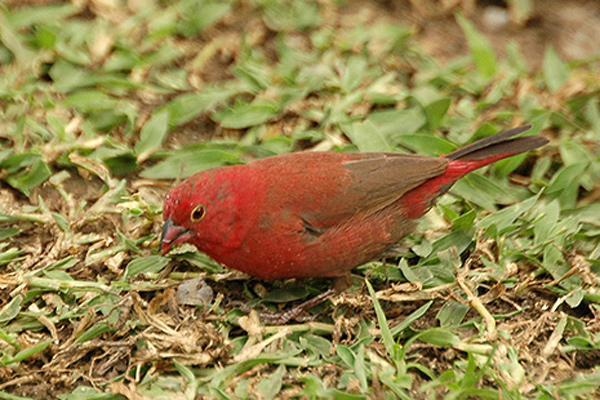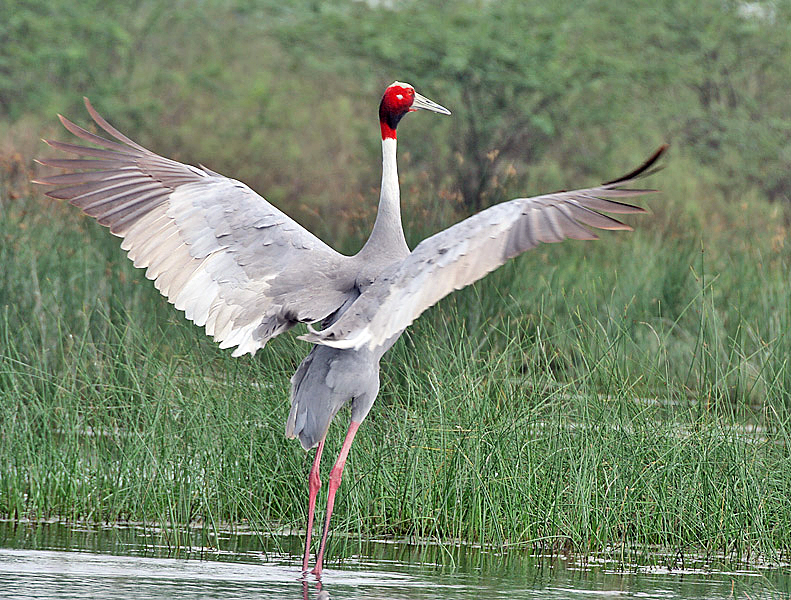We all know that highly social, intelligent birds such as parrots do not fare well when bored. Excessive screaming, feather-plucking, pacing and other harmful behaviors quickly take hold when parrots are kept alone and left without stimulation. Macaws are especially hard to accommodate – their incredible strength and boundless energy present a real challenge to owners seeking to keep them busy. A spate of questions on this topic, posed recently by macaw owners, has prompted me to write this article. Read More »
Category Archives: General Bird Care
Feed SubscriptionThe Red-Billed or African Firefinch – Captive Care and Breeding
 Also known as the Senegal Firefinch (Lagonosticta senegala), this spectacular African import is one of the few entirely red-colored birds available to aviculturists. Northern Cardinals, one of my favorites, are not legal to keep here in the USA…the Red-Billed Firefinch is the only species I’ve found that comes close to matching it’s brilliant plumage. They are not rare in the wild or captivity, but never lose their appeal – even to lifelong bird keepers, Firefinches always seem “special”.
Also known as the Senegal Firefinch (Lagonosticta senegala), this spectacular African import is one of the few entirely red-colored birds available to aviculturists. Northern Cardinals, one of my favorites, are not legal to keep here in the USA…the Red-Billed Firefinch is the only species I’ve found that comes close to matching it’s brilliant plumage. They are not rare in the wild or captivity, but never lose their appeal – even to lifelong bird keepers, Firefinches always seem “special”.
Range and Habitat
Ranging throughout much of Africa south of the Sahara, Firefinches have adapted well to people…in many developed areas their chirping is among the most familiar of the day’s sounds. The typical natural habitat is savanna, overgrown scrub and the edges of lightly-wooded areas.
Several related species, some of which are equally as gorgeous as the Red-Billed Firefinch, also occur in Africa, but none are well-established in captivity. Read More »
The Great Crane Escape or “Should I Trim My Bird’s Flight Feathers?” – Part 2
 In Part 1 of this article I mentioned some general considerations regarding the trimming of flight feathers, and then launched into a story about a huge Saurus Crane (Grus antigone) that, while under my care at the Bronx Zoo, launched itself into the air and went sailing out over the South Bronx (its previously trimmed flight feathers had grown back in with astonishing rapidity). I continue with the story here….
In Part 1 of this article I mentioned some general considerations regarding the trimming of flight feathers, and then launched into a story about a huge Saurus Crane (Grus antigone) that, while under my care at the Bronx Zoo, launched itself into the air and went sailing out over the South Bronx (its previously trimmed flight feathers had grown back in with astonishing rapidity). I continue with the story here….
Brave Young Bird Keeper to the Rescue
Amazingly, while I was out searching for the nearly 6-foot-tall Saurus Crane, a 13-year-old boy of slight stature showed up at the zoo with the huge bird in tow. He had its rapier-like bill, which had sent one keeper to the hospital for stitches in the past, tucked beneath his arm, exactly as should be done with potentially dangerous birds. Read More »
Socialization – a Vital First Step When Training Your Parrot – Part 2
 In Part I of this article we discussed the importance of socialization – the process of familiarizing your parrot with the people and things that make up its world. Wild parrots are socialized by their parents, mates and flock members, but most or all of these important individuals may be unavailable to captives. Un-socialized parrots generally live stress-filled lives and remain fearful of people. Today we’ll take a look at some simple and effective socialization techniques. Read More »
In Part I of this article we discussed the importance of socialization – the process of familiarizing your parrot with the people and things that make up its world. Wild parrots are socialized by their parents, mates and flock members, but most or all of these important individuals may be unavailable to captives. Un-socialized parrots generally live stress-filled lives and remain fearful of people. Today we’ll take a look at some simple and effective socialization techniques. Read More »
The Great Crane Escape, or “Should I Trim My Bird’s Flight Feathers”? – Part 1
The trimming of flight feathers is often touted as an important first step in training parrots and other birds, but the process has many other important implications that should not be overlooked. Parrots, finches, softbills, quails – and, as you’ll see, Saurus Cranes – each present different considerations, as do your reasons for keeping the birds and the situations in which they are housed.
Age Considerations
It is true that, in general, birds with clipped wings are easier to work with and train than are those capable of flight. This is the most common reason that owners trim flight feathers, and the fact that the feathers will grow back does seem to provide an “insurance policy” of sorts, in case all does not go as planned. Read More »
 That Bird Blog – Bird Care and History for Pet Birds
That Bird Blog – Bird Care and History for Pet Birds
